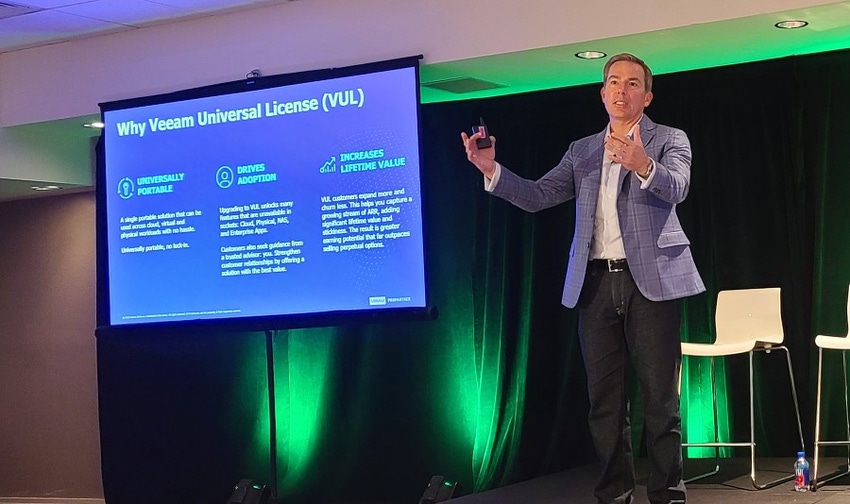VUL migration is among several partner growth priorities shared by Veeam’s top leaders.
May 31, 2023

Nearly a year after Veeam stopped offering perpetual socket-based licenses, the data protection provider is urging partners to migrate the many customers that still use those licenses to Veeam Universal License (VUL) bundles.
Migrating customers to VUL is among several key growth opportunities outlined by the top leaders of Veeam, which sells only through partners. Veeam’s top leaders emphasized that at its annual VeeamON conference in Miami last week.
During a partner session at the conference, Veeam executives also stressed selling the new Veeam Data Platform, cross-selling its various offerings to expand Veeam’s enterprise footprint and promoting the company’s Microsoft 365 and other SaaS protection solutions.
But partners should make Veeam Universal License migration a key priority, company leaders emphasized. Speaking to Veeam partners last week, chief revenue officer John Jester said that since launching VUL nearly four years ago, customers who bought them were more likely to renew them and add more workloads.
“When you get a customer on VUL, it creates a revenue stream for you; it’s easier to renew, expand, and grow,” Jester (pictured above) told partners.
While Veeam launched VUL as an option for customers to protect all their workloads, the company charted its current $1 billion-plus annual growth rate to its perpetual licenses, assigned to a physical or virtual socket. As of July 2022, Veeam stopped letting partners sell new perpetual licenses but said customers could keep existing ones.
CEO Pitches Veeam Universal License (VUL)
CEO Anand Eswaran acknowledged that many partners don’t see the modernization benefit of moving customers off their socket-based perpetual license to a Veeam Universal License. Nevertheless, driving customers from a perpetual license to VUL brings them into the new Veeam Data Platform Foundation edition, which provides core backup and recovery of hybrid environments, cloud, physical and virtual workloads.
“There’s an immediate opportunity, if you do this right, to get them to the Advanced or Premium or Veeam One and Veeam Recovery Orchestrator,” Eswaran told partners at the event. “So that’s the upsell opportunity, which is immediate. Obviously, then comes the breadth of cross-sell opportunities, especially for the hybrid cloud.”
According to Eswaran, the churn rate for customers that move to Veeam Universal License is half the rate of those on sockets.
“We’re very proud of our gross retention numbers,” Eswaran said. “Just think about the lifetime value of a customer when they move to VUL,” he said.
As for cross-selling, Eswaran noted that there are at least 345 million Microsoft 365 subscriptions based on data from over a year ago. Based on various reports, Eswaran said less than 50 million of them are unprotected by a backup and recovery solution. Veeam protects about one-third of them, he added.
“We are at that inflection point where everyone recognizes that you need to protect your Microsoft 365 data,” Eswaran said. “And I feel that the inflection point will trigger a massive growth opportunity. I’m counting on you to take that rocket ship to the next level.”
He noted that since launching its new Salesforce data protection option, Veeam has signed on 100 customers.
Beyond Virtual Machines
According to Veeam’s telemetry, customers use 82% of its data protection instances to protect virtual machines. But Jester noted that with more workloads transitioning to SaaS (including Microsoft 365), and hybrid and modern cloud-native apps, these workloads are the ones in need of protection.
In the last year-and-a-half, Jester emphasized a more rapid shift in mission-critical workloads that customers have moved into production.
“So, when your customers are talking about Kubernetes, they’re talking about app modernization; think about how you position Kasten so that we can protect those workloads in the future,” Jester said.
“I think it’s a great technology solution,” he added. “But we also engineered it so that you could monetize it. Every time you get a customer to go from foundation to advanced, that’s 25% more revenue for all of us. Every time a customer goes to the premium edition, that’s 51% more revenue. So, we have built a huge growth opportunity into our customer base.”
Deeper Into the Enterprise
Among its 450,000 customers, 76,000 are enterprises, Jester said, adding that 54% of the company’s $1.4 billion in revenue last year came from those enterprise customers. While he noted that 82% of the Fortune 500 and 72% of global 2000 companies use Veeam, Jester said cross-selling the broader portfolio and getting deeper into those organizations is a key priority.
Jester told partners that Veeam is piloting an Enterprise License Agreement (ELA) program.
“It’s not done yet; it’s not in production,” he emphasized. “You may have heard about it because we’ve done previews with some customers. But this is something that we’re to have in the second half of the year.”
Read more about:
VARs/SIsAbout the Author(s)
You May Also Like


